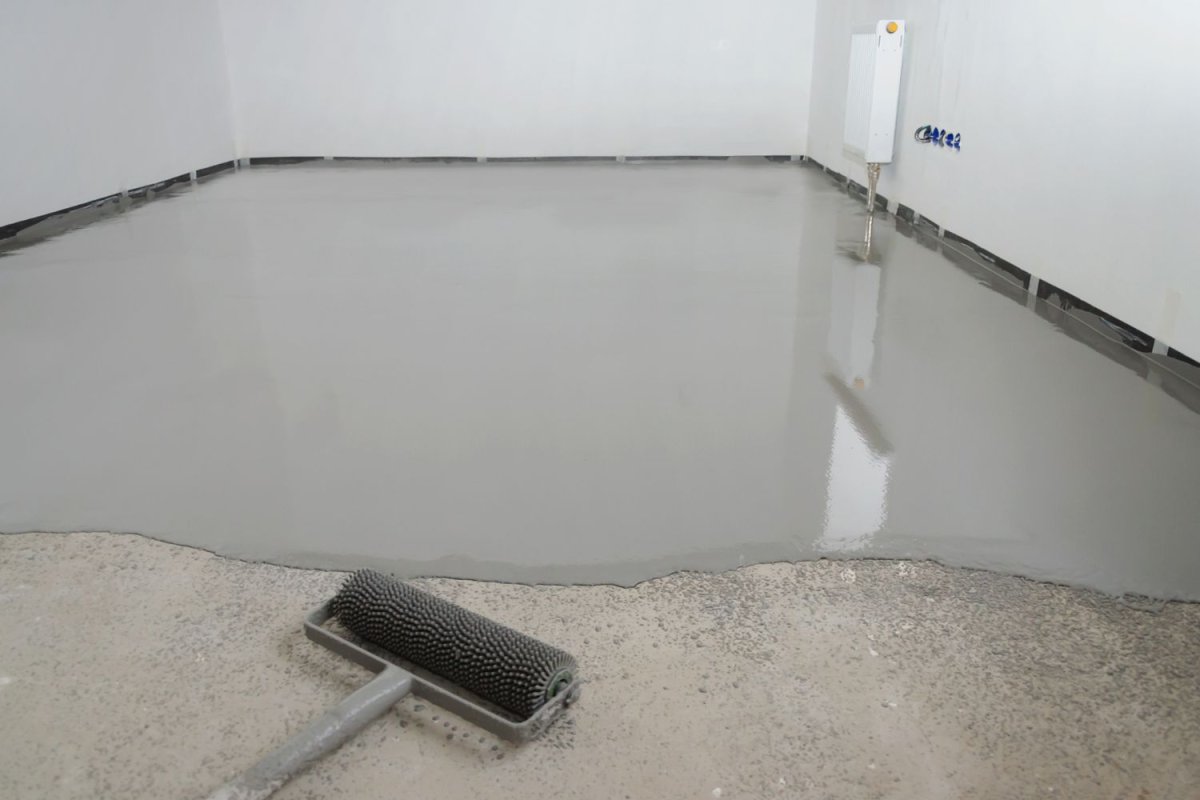We may earn revenue from the products available on this page and participate in affiliate programs. Learn More ›
- Typical Range: $1,536 to $3,840
Polished concrete floors have a great deal to offer in terms of style, durability, and longevity. With an almost limitless variety of colors, finishes, shines, designs, textures, and styles for homeowners to choose from, it’s hard to think of a place in the home where polished concrete floors don’t fit in.
Concrete floors have come a long way over the years, making them an ideal flooring choice for new builds and remodeling projects alike. But just how much do polished concrete floors cost, and what benefits do they offer?
According to Angi and HomeAdvisor, polished concrete floors have an installation price range of $1,536 to $3,840. This makes the average polished concrete floor cost an affordable option for most new flooring budgets. This guide will cover the factors that affect the final price of polished concrete floors, the ways homeowners can save money on installation, and the advantages concrete floors have over other types of flooring.
Factors in Calculating Polished Concrete Floor Cost
There are many factors that influence polished concrete floor costs. The floor’s size is one of the most influential factors, but others to consider are floor location, polish level, and desired style. Homeowners trying to understand what goes into polished concrete flooring estimates can refer to the following factors.
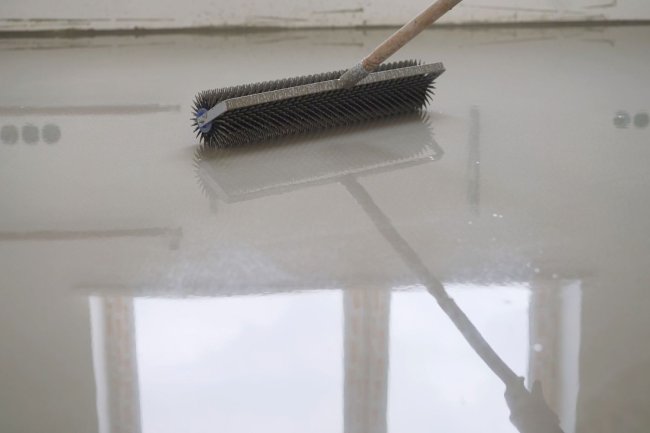
Floor Size
Flooring installation cost can vary by material. But just like the pricing for hardwood floors, tile, and carpet, concrete floor pricing is greatly influenced by size. And just like the installation of most other types of flooring, concrete floor installation is often quoted by square foot. While every concrete floor job is unique, most standard jobs fall into a price range of $2 to $8 per square foot.
For jobs requiring repairs or a completely new concrete slab, costs are likely to increase. In some scenarios, concrete floor installation costs can range from $15 to $30 per square foot.
Homeowners looking to add concrete flooring to their home will want to match up the space to their budget. For example, a small budget of $1,000 will likely be enough to cover a space measuring about 200 square feet with a simple polished concrete floor. Those seeking more style, texture, and finish can expect to pay about $6,000 for the same space.
Polish Level
There are different levels of gloss and shine that homeowners can choose from when polishing a concrete floor. A high-shine finish may be appropriate for an entryway, whereas a less subtle gloss finish may be desired for a living space. Different levels of shine are achieved through different grit numbers just as they are with sandpaper. While a 200-grit concrete finish is good enough for industrial spaces, a higher grit will be used for residential spaces.
Concrete floor polishing cost is directly related to the level of polish a homeowner desires for their concrete floors. Generally speaking, the higher the polish level, the higher the price. For estimation purposes, homeowners will want to know that every additional level of polish tacks on an additional $0.35 to $0.75 per square foot.
Grade Level
Grade level refers to the floor or story of a home. A basement is considered below grade, while a second-story bedroom is considered above grade. Rooms on the first floor of a home are considered on grade.
Grade level can affect the cost of a polished floor installation, especially when it comes to an above-grade concrete floor. This type of installation requires either structural reinforcement or a cement-board underlayment to support the weight of the floor. An engineer or architect will need to assess the home to see which type of support is required. Either way, an above-grade concrete floor can cost an additional $2 to $5 per square foot.
Floor Location
Concrete floors can have different price ranges depending on their location as well. For example, a polished concrete patio follows the standard price range of $3 to $8 per square foot. Homeowners may want to consider having an anti-slip coating applied for an additional cost to help prevent the surface from getting slippery during rainstorms. If a more high-end design is desired, concrete patio costs can be as much as $16 per square foot.
Concrete floors are common in basements, and they can be stained, painted, or polished for style. Concrete is a great basement flooring choice, since it’s mold- and mildew-resistant and doesn’t absorb odors. Polished concrete basement floors have an average price range of $3 to $12 per square foot.
When homeowners are installing concrete driveways, sidewalks, or stairs, projects are often charged per yard. Concrete costs per yard vary between $100 and $200.
Style and Finish
Concrete floors are incredibly versatile and offer homeowners plenty of style and finish options. Homeowners can customize their concrete floors either to complement their home’s style or to create a standout piece of floor art. Generally speaking, the more complex the design, the more a homeowner can expect to pay.
Basic sealed concrete costs an additional $0.85 to $1.60 per square foot. It’s the most affordable finish, and while it doesn’t offer much unique style, it’s still a stunning polished finish. Painted and sealed concrete floors cost a bit more, coming in around $1.50 to $3 per square foot. A little bit of color can make all the difference, since paint can hide the natural appearance of concrete and make it look more appealing.
For homeowners who want to retain the look of the concrete without feeling stuck with gray tones, stained concrete is an option. Staining costs an additional $2 to $10 per square foot. Concrete can also be finished to mimic wood, tile, or stone, offering a homeowner a high-end finish without the added maintenance of real wood, tile, or stone. This finish starts at about $3 per square foot but rarely costs more than $6.
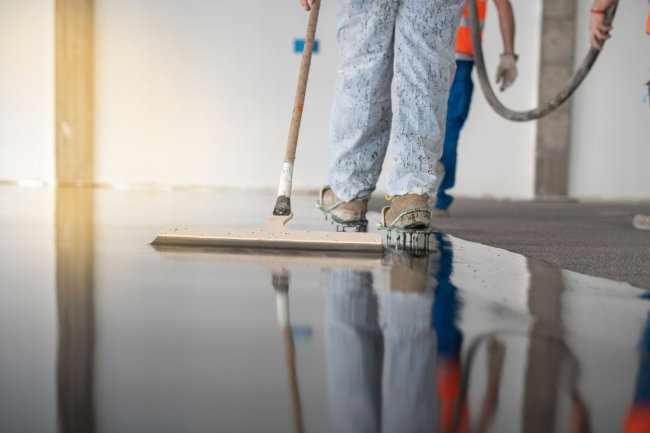
Additional Costs and Considerations
Some concrete flooring projects are simple and straightforward, while others require a few more steps or considerations to get the job done. Homeowners may not come across all of the following potential additional costs when installing a concrete floor, but awareness can help prevent a budget-busting surprise.
Commercial vs. Residential Flooring
Is there a cost difference between commercial and residential polished concrete flooring? In most cases, the answer is yes. The materials and installation process are the same, but there are a few key differences that influence the final price.
The first is that commercial spaces are typically larger. Like many other supplies and products, materials can be less expensive when purchased in bulk. But what may be more influential in the price difference between commercial and residential flooring jobs is that commercial spaces tend to be wide open, allowing contractors to use larger pieces of equipment to speed up the process. In residential spaces, smaller amounts of material and tighter spaces can add to higher overall costs for polished concrete flooring.
Existing Floor Repair
If an existing concrete slab has significant damage, the surface will need to be repaired before a new polished concrete floor can be installed. Such damage could include holes or cracks that could lead the new floor to become weaker over time instead of stronger.
Each repair job is unique, as there are different products and approaches for different types of floor damage. But as a general estimate, homeowners can expect to pay between $0.50 and $2 per square foot for floor repairs. However, extensive damage could put the floor past the point of basic repair. If the floor needs total resurfacing, for example, the repair cost is likely to be between $4 and $10 per square foot.
Existing Floor Removal
In some cases, an existing floor may be so far beyond repair that resurfacing isn’t even an option. In this scenario, the only choice a homeowner has is to remove the old flooring before the new can be installed. This is often a surprise cost that can quickly eat into a budget.
Should an existing floor have to be removed, a homeowner can expect to pay between $0.25 and $0.50 per square foot. However, this is just for the removal. There could be additional disposal fees to consider depending on the material. If disposal is included in the price of removal, the cost per square foot could be as high as $3 per square foot to remove an existing floor.
Additional Surfaces
Depending on the home, room, and homeowner’s style, it can make sense to extend concrete past the floors. Some contractors find themselves installing concrete on floors, walls, countertops, and worktop benches all on the same job.
For example, polished concrete walls can create a uniformed look while adding durability to a space that drywall just can’t offer. Compared to other building materials, concrete is more resilient and energy efficient. Concrete walls are also low maintenance, and thanks to all the different finishing techniques available, a dreary gray slab is far from the only option. Polished concrete walls cost between $10 and $60 per square foot.
Countertops are another common surface for polished concrete. Concrete countertops can be custom-sized and shaped. Once installed, they are difficult to scratch and impervious to heat. Compared to countertops made from other materials, they are durable and can even improve a home’s resale value. Concrete countertops cost $60 to $130 per square foot.
Customizations
One of the greatest benefits of concrete floors is the homeowner’s ability to customize colors, designs, and textures to create a truly one-of-a-kind showpiece. Of course, the more intricate the design, the higher the price is likely to be.
For example, a basic polished concrete floor costs between $2 and $8 per square foot. It’s typically simple in color and slightly more matte in appearance. Floors that feature a bit more gloss or multiple colors have a higher price range of $5 to $12 per square foot. Floors in this price range may also use stencils or feature patterns.
Polished concrete floors using intricate patterns, vibrant color schemes, and captivating designs cost the most. Highly customized concrete floors cost between $8 and $16 per square foot. Modern polished concrete floors in this price range are also typically highly glossed.
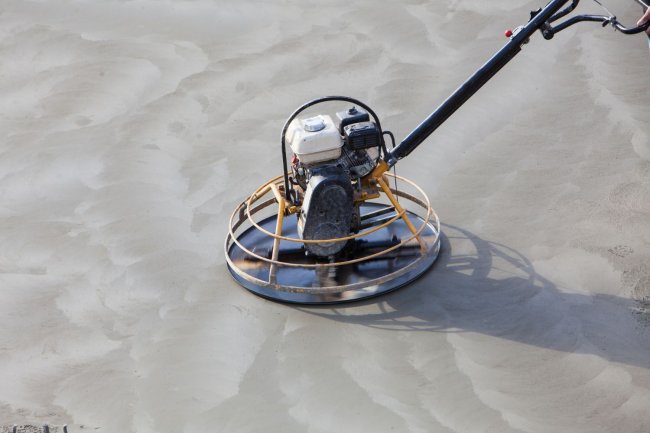
Types of Polished Concrete Floors
When researching polished concrete floors pros and cons, many homeowners are surprised to learn just how many different styles and finishes concrete floors offer. While other flooring types have limited style selections, concrete floors can be customized to suit a homeowner’s individual taste. Below are some of the most common types of polished concrete floors for homeowners to consider.
Wood-Look
Concrete can be stamped to mimic the look of solid hardwood planks. While this approach doesn’t save a ton of cash in terms of materials and labor, it does provide other benefits. For example, concrete floors don’t fall victim to scratches and gouges. While spills can stain concrete, moisture can cause hardwood floors to warp or split. Hardwoods can also become creaky over time, which concrete will never do.
Stamping is the best way to get a wood look on concrete (the process can also mimic stones or tiles). Basic stamped concrete floors that look like solid hardwood planks cost between $3 and $6 per square foot.
Stained
Staining is a quick and affordable way to enhance the aesthetic appearance of concrete flooring. Stain can add beauty and depth to any space while making concrete floor maintenance even easier.
Homeowners who know how to stain concrete floors may be able to complete this as a DIY project. Stain is typically applied with a sprayer and penetrates the surface of the concrete, creating a long-lasting color effect. However, many homeowners find that the price a contractor charges is more than fair due to the time and frustration that hiring a pro saves them.
Homeowners can expect to pay $2 to $4 per square foot for a stained concrete floor, though the average cost can be close to $10. Stained designs featuring multiple layers can cost up to $15 per square foot.
Sealed
Despite their shine, polished floors are not typically sealed. Instead of relying on a layer of sealant to provide a glossy finish, standard polished floors simply use special penetrating liquids to prevent spots and scuff marks. However, adding a layer of sealant to a polished concrete floor can be beneficial, especially in high-traffic areas, to help protect the floor from damage.
For homeowners seeking the benefits of sealing, epoxy is one of the best concrete sealers to consider. It adds supreme durability and protects from chemicals, heavy traffic, oils, and moisture. The cost to seal a concrete floor depends on the size of the floor. Sealing a large space can cost as little as $0.85 to $1.60 per square foot. Sealing a smaller space can be more time-consuming and difficult, so costs can be as much as $10 per square foot.
Painted and Sealed
Paint can be rolled or brushed over concrete for a quick and easy aesthetic change. While this is a very cost-effective method to spruce up a concrete floor, paint is prone to chipping over time. Maintenance is key with a painted concrete floor. Homeowners can expect to pay between $1.50 and $3 per square foot for a painted concrete floor.
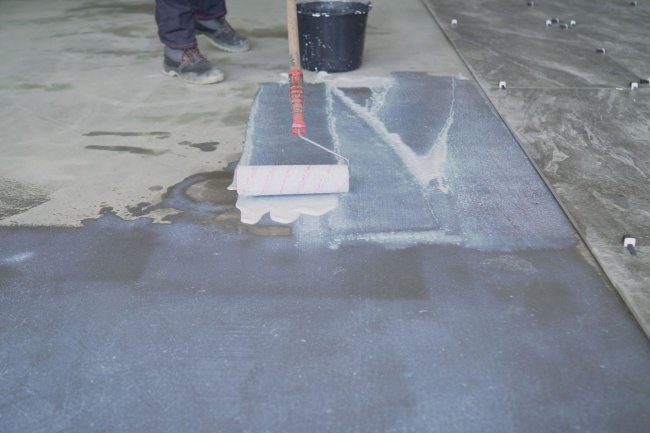
Benefits of Polished Concrete Floors
In spite of its slick appearance, a polished concrete floor actually offers a safe and nonslippery surface for residential spaces. But that’s not the only benefit this stylish flooring offers. Below are just some of the top benefits of polished concrete floors that homeowners can expect if they choose this versatile flooring option.
Cost Effectiveness
Compared to other flooring options, polished concrete floors are incredibly cost-effective. The material costs for concrete floors are low and stable, and the installation process is more efficient than for some other types of flooring, ensuring labor costs don’t force a project to go over budget.
But what really makes concrete floors so cost-effective is the high durability they offer. Where other types of flooring, like carpeting, linoleum, or even hardwood, start to show wear and tear within a few years of installation, concrete flooring can look as good as the day it was installed for decades to come.
With other types of flooring, it’s a matter of when they will need to be replaced and not a question of if. But with concrete flooring, homeowners can rest easy knowing their investment is likely to outlast any other flooring option they could have chosen.
Low Maintenance
Maintaining and cleaning polished concrete floors are simple. Daily dust mopping or sweeping is recommended to prevent dirt accumulation, along with mopping about once a week with a damp microfiber mop. These quick tasks should be enough to remove smudging, scuffs, and water marks while leaving behind a glossy finish.
When it comes to other flooring options, like tile and linoleum, aggressive scrubbing is often the only way to maintain a sanitary environment and clean appearance. Vacuuming alone is rarely enough to keep up on carpeted flooring. Time-consuming carpet cleaning procedures are a common maintenance task, but because the material in polished concrete surfaces is so tightly compacted, it doesn’t take much energy to keep them visually stunning and well maintained.
Durability
Concrete flooring is, quite literally, a solid investment for homeowners due to its durability. It resists weathering, erosion, and natural disasters. While these are unlikely issues in an indoor kitchen or living space, such qualities serve as a testament to the material’s strength and longevity.
In fact, concrete never cures completely. This means that concrete is always hardening a bit more each day. So in theory, a polished concrete floor only gets stronger over time, where most other flooring options get weaker as time goes on.
While concrete doesn’t last forever, it is certainly one of the most durable flooring materials.
Versatility
Polished concrete floors offer beautiful design options and the potential to customize both looks and functionality to meet a homeowner’s unique flooring needs and preferences.
Aesthetically, concrete floors can be basic and understated or serve as a room’s main focal point. Dye can be added to wet concrete to create a vast range of earthy and bold colors. Surface treatments can create one-of-a-kind finishes while stamps can add quirky or sophisticated polished concrete floor textures. Concrete can be styled to even mimic other materials like tile, stone, or brick.
When it comes to functionality, concrete floors can often be designed with radiant floor heat. With the ability to visually impress while adding an element of comfort, concrete is a truly versatile flooring option.
Sustainability
Many flooring types are detrimental to the environment. They either use up natural resources or are made from materials that take time to fully break down once removed. However, concrete is an eco-friendly flooring option, as it doesn’t deplete natural resources and requires less energy to produce.
Concrete contains no harmful volatile organic compounds (VOCs) and can be finished with zero-VOC sealers, protecting indoor air quality. Concrete also absorbs warm and cool air, which positively impacts a home’s heating and cooling costs.
Finally, should a concrete floor need to be removed, waste is minimal compared to that of other flooring options. Concrete can also be recycled. For a homeowner looking for eco-friendly building materials, concrete is an ideal choice.
Mold and Mildew Resistance
Another benefit of concrete floors is that they’re mold- and mildew-resistant, which is tremendously beneficial for a home’s inhabitants, human and furry alike.
Mold and mildew love organic materials, like wood. That’s why decks and outdoor wooden benches are common sources for mold growth if left untreated. But concrete is not an organic material, so as long as the surface is sealed, routinely cleaned, and kept dry, mold and mildew growth is nearly impossible.
Exposure to mold spores can cause allergic reactions in people and pets, including watery eyes, runny nose, coughing, sneezing, headache, and fatigue. Over time, these reactions can get more serious. For homeowners concerned about mold and mildew for hygienic or health-related reasons, concrete floors are a great option.
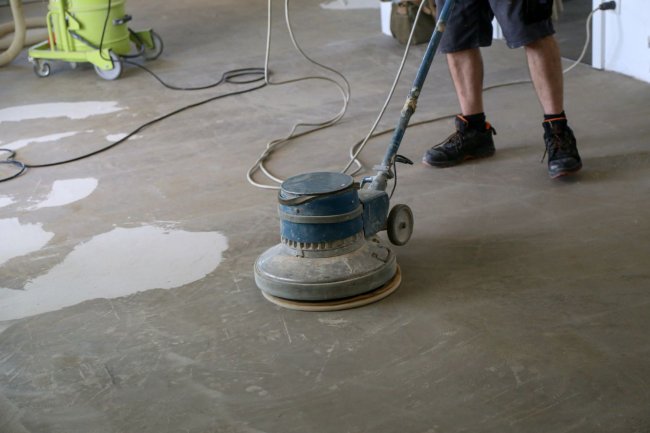
Polished Concrete Floor Installation: DIY vs. Hiring a Professional
Tackling a DIY polished concrete floor is a complex and time-intensive job. Even for a skilled homeowner, installing a concrete floor isn’t DIY-friendly.
Besides needing to have the right skill set to prep and pour concrete and also to know how to level a concrete floor, homeowners have to consider the cost of tools. The average cost of a grinder rental is between $460 and $1,280. A vacuum rental costs at least $105, while diamond polished pads and discs can cost up to $725.
Once materials and time are added to the budget, a homeowner is likely better off hiring a concrete professional to install their floors. Not only will they bring the required tools and experience, they’ll also make sure the job is done on time and with the best final results possible.
While installing a concrete floor is best left to the pros, polishing the concrete is a job that some homeowners will feel comfortable taking on themselves. The process is very similar to sanding wood, so knowing how to polish concrete floors usually comes down to doing just a bit of research.
Using the proper polishing tools is crucial, which is why many homeowners still turn this job over to the pros. But for a determined DIYer, a concrete floor polisher rental can ensure they’re properly equipped for the job. Homeowners will also want to consider the cost of safety equipment, including safety shoes, gloves, eye protection, and respirator (all which are typically required when renting a polishing unit).
Polished concrete floors are an investment that can last for decades so whenever in doubt, a homeowner will want to bring in a professional for the job.
How to Save Money on Polished Concrete Floor Cost
The average cost of polished concrete floor installation ranges from $1,536 to $3,840. This is a higher installation cost range than for other types of flooring, like carpet or vinyl tile, but with a higher average cost comes the opportunity to save money. All it takes is a bit of planning and a thorough understanding of concrete floor maintenance. Homeowners will want to keep the following tips in mind when looking for ways to save on a concrete floor installation.
- Get several installation quotes. When having a concrete floor installed for the first time, speak to multiple contractors. Not only will this ensure you hire the best professional for the job, but it can also help you spot inflated quotes.
- Consider multiple styles. Concrete floors are quite versatile, and there may be more than one way to get a desired finish or look. There is a seemingly endless list of polished concrete floor colors and textures to choose from. Discuss your project in detail with your contractor to find the most affordable approach to your desired final look.
- Clean up spills right away. Certain liquids can quickly eat through a concrete floor’s top layer, leaving it visibly less shiny than the rest. This is especially true with acidic drinks like orange juice and lemonade. Cleaning up spills right away can save money on repolishing.
- Avoid dragging furniture or heavy objects across a polished concrete floor. This can quickly (and unevenly) wear down the polished surface. Avoiding unnecessary repolishing jobs is one of the best ways to save on polished concrete floor maintenance costs.
- Keep up on routine maintenance. Clean your polished concrete floors on a regular basis. Most concrete floors need to be polished every 2 to 3 years. To keep up on the shine in between polishing appointments, wipe the concrete floors with a microfiber mop every day and wet-mop once a week.
Questions to Ask About Polished Concrete Floor Installation
Installing flooring is a specialty all its own. Finding a professional contractor with experience installing polished concrete floors can take a little digging. For homeowners searching for a pro experienced in residential polished concrete floors, asking the following questions may help narrow down a list of contenders, revealing the best contractor for the job.
- How much experience with concrete do you have?
- What type of concrete jobs have you done before?
- Have you installed multiple concrete floors in the past?
- Will you use a concrete that can be polished to achieve the ideal final look?
- Are you certified by the ACSS (American Society of Concrete Contractors)?
- Do you have a portfolio of previous work for me to look at or a list of references I can reach out to?
- Are you licensed and insured for this type of work?
- Do you work alone or with a crew? If with a crew, how are they trained?
- How soon can my project start?
- How long do you expect the project to last?
- What type of prep work needs to be done beforehand to protect my belongings and nearby surface areas?
- Do you handle securing permits and scheduling inspections if they are required?
- What type of maintenance do you suggest so I can get the most out of my new floors?
- Do you work with a written contract or offer any guarantees on your work?
- Who do I contact if I notice an issue with my flooring after installation?
FAQs
Polished concrete is a durable, stain-proof, and chic flooring option for homeowners looking to go beyond basic carpet and wood flooring.
The average polished concrete floor cost can be difficult to pinpoint, especially with so many customizable options to choose from. Homeowners can browse through the following FAQs to gain additional insight into the benefits, maintenance, and cost of polished concrete flooring.
Q. How do I clean my polished concrete floors?
Cleaning a polished concrete floor is a simple process. Mopping with a floor cleaner designed for polished concrete floors is best. This can also boost stain resistance. Another option is mopping with natural, concentrated, pH-neutral soap. Mix a few drops into a bucket with warm water, and wipe with a microfiber wet mop. Avoid ammonia, vinegar, bleach, or other cleaning products not designed for polished concrete floors. They can dull, discolor, or etch the flooring.
Q. What’s the difference between concrete and cement?
Concrete and cement are not the same material. Cement is actually an ingredient of concrete, which consists of such materials as sand, gravel, and crushed stone. These aggregates are mixed with a paste made of water and Portland cement to create concrete. By volume, cement makes up between 10 percent and 15 percent of a standard concrete mix.
Q. How do I remove stains from polished concrete floors?
It’s difficult to remove a stain from polished concrete floors, so taking preventive measures is the best approach. When a spill does occur, the liquid should be mopped up as quickly as possible. Then the entire area should be cleaned with a warm soap and water mixture to dilute and neutralize any remaining residue. If a stain still comes through, help from a professional floor cleaner may be the next step.
Q. Is a polished concrete floor expensive?
Polished concrete floors offer a contemporary feel that fits into many home styles, making it a popular choice for homeowners looking for a flooring option beyond the standard choices. A simple 200-square-foot polished concrete floor can be as affordable as $600, but as designs get more complex, adding a polished concrete floor to the same space could cost as much as $6,000.
Q. How much does it cost to clean and seal concrete?
On average, it costs between $1.20 and $1.75 per square foot to have a contractor clean and seal concrete flooring, although the final cost depends heavily on the type of sealant used. The most affordable is acrylic, while polyurethane has a bit higher price range. Epoxy sealer is the most expensive and can cost up to $7 per square foot, but it leaves a high-quality polish behind.
Q. Are polished concrete floors slippery?
A polished floor’s shine can make it appear slippery. Surprisingly, though, polished concrete floors are actually up to 50 percent more slip-resistant than the national standard for a low-slip floor based on how much a person’s weight is converted into grip. Additionally, because of their uniform surface, polished concrete floors are extremely easy to keep clean. This keeps them free of contaminants that can leave flooring not just soiled but slippery.
Sources: Angi, HomeAdvisor, HomeGuide, Blackrock Industrial, House Digest
